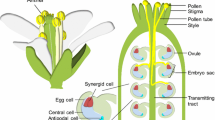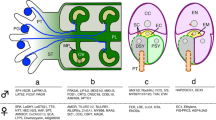Abstract
In angiosperms, the female gametophyte has a secluded life; it is protected by several concentric layers that envelop each other. The embryo sac is surrounded by the nucellus, which in turn is wrapped by the integuments forming the ovule, which is nested in the ovary. These wrappings are not hermetic, but contain little ”gates” the pollen tube must traverse on its way towards the embryo sac. Information is emerging that shows that the ovary and ovule provide signals orienting and directimng the pollen tube on the right course. There are three main bodies of evidence supporting this hypothesis. One relates to developmental changes in the female tissues and how they affect pollen tube growth. The second refers to defective ovule mutants, which induce defective pollen tube guidance. And the third relates to the possible molecules involved in this signalling. Here, information gathered along these three main lines of evidence is reviewed. All converge to the conclusion that different checkpoints exist all along the pollen tube pathway. These checkpoints provide active signalling that guides the pollen tube to its destination, the embryo sac.
Similar content being viewed by others
Author information
Authors and Affiliations
Additional information
Received: 15 December 2000 / Accepted: 13 June 2001
Rights and permissions
About this article
Cite this article
Herrero, M. Ovary signals for directional pollen tube growth. Sex Plant Reprod 14, 3–7 (2001). https://doi.org/10.1007/s004970100082
Issue Date:
DOI: https://doi.org/10.1007/s004970100082




